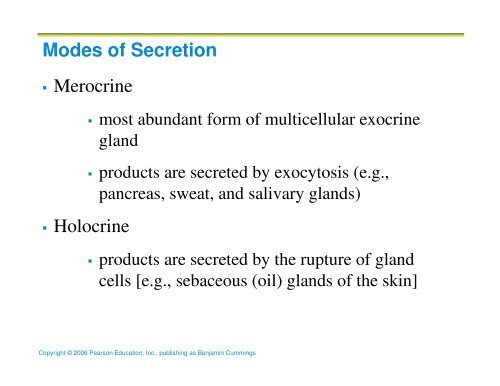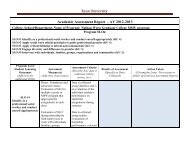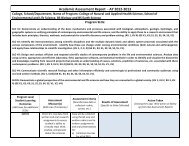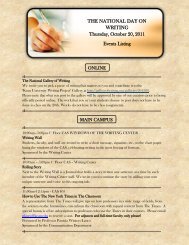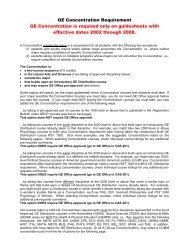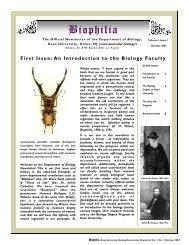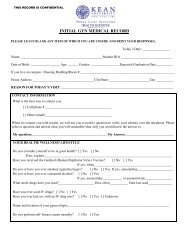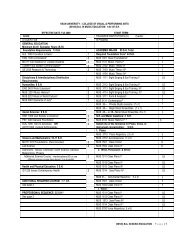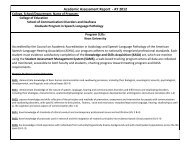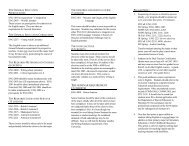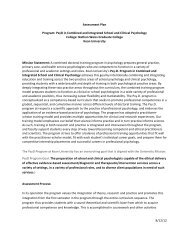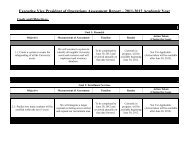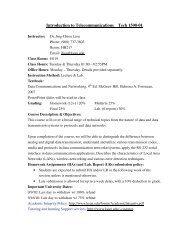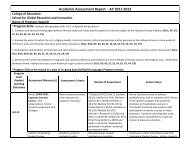Modes of Secretion Merocrine Holocrine
Modes of Secretion Merocrine Holocrine
Modes of Secretion Merocrine Holocrine
You also want an ePaper? Increase the reach of your titles
YUMPU automatically turns print PDFs into web optimized ePapers that Google loves.
<strong>Modes</strong> <strong>of</strong> <strong>Secretion</strong><br />
<strong>Merocrine</strong><br />
<strong>Holocrine</strong><br />
most abundant form <strong>of</strong> multicellular exocrine<br />
gland<br />
products are secreted by exocytosis (e.g.,<br />
pancreas, sweat, and salivary glands)<br />
products are secreted by the rupture <strong>of</strong> gland<br />
cells [e.g., sebaceous (oil) glands <strong>of</strong> the skin]<br />
Copyright © 2006 Pearson Education, Inc., publishing as Benjamin Cummings
<strong>Modes</strong> <strong>of</strong> <strong>Secretion</strong><br />
Copyright © 2006 Pearson Education, Inc., publishing as Benjamin Cummings<br />
Figure 4.5
Connective Tissue<br />
Found throughout the body; most abundant and<br />
widely distributed in primary tissues<br />
Connective tissue proper<br />
Cartilage<br />
Bone<br />
Blood<br />
Copyright © 2006 Pearson Education, Inc., publishing as Benjamin Cummings
Connective Tissue<br />
Copyright © 2006 Pearson Education, Inc., publishing as Benjamin Cummings<br />
Figure 4.6
Functions <strong>of</strong> Connective Tissue<br />
Binding and support<br />
Protection<br />
Insulation<br />
Transportation<br />
Copyright © 2006 Pearson Education, Inc., publishing as Benjamin Cummings
Characteristics <strong>of</strong> Connective Tissue<br />
Connective tissues have:<br />
Mesenchyme as their common tissue <strong>of</strong> origin<br />
Varying degrees <strong>of</strong> vascularity (avascular to highly<br />
vascularized)<br />
Nonliving extracellular matrix, consisting <strong>of</strong><br />
ground substance and fibers. Connective tissue can<br />
bear weight, withstand tension and endure abrasion<br />
Copyright © 2006 Pearson Education, Inc., publishing as Benjamin Cummings
Structural Elements <strong>of</strong> Connective Tissue<br />
Ground substance – unstructured material that fills<br />
the space between cells<br />
Fibers – collagen, elastic, or reticular<br />
Cells – fibroblasts, chondroblasts, osteoblasts, and<br />
hematopoietic stem cells<br />
Ground substance and fibers make up the<br />
extracellular matrix<br />
Copyright © 2006 Pearson Education, Inc., publishing as Benjamin Cummings
Ground Substance<br />
Unstructured material that fills the space between<br />
the cells and contains the fibers<br />
E.g. Interstitial (tissue) fluid<br />
E.g. Adhesion proteins – fibronectin and laminin<br />
E.g. Proteoglycans – glycosaminoglycans (GAGs)<br />
Functions as a molecular sieve through which<br />
nutrients diffuse between blood capillaries and<br />
cells<br />
Copyright © 2006 Pearson Education, Inc., publishing as Benjamin Cummings
Ground Substance: Proteoglycan Structure<br />
Proteoglycans consist <strong>of</strong> a protein core to<br />
which glycosaminoglycans are attached<br />
e.g. chondroitin (buy ‘em over the counter<br />
e.g. keratin sulfates<br />
e.g. hyaluronic acid<br />
Proteoglycans can form huge aggregates<br />
attached to a hyaluronic acid molecule<br />
GAGs intertwine and trap water forming<br />
a gel like substance<br />
The ground substance functions as a medium<br />
through which nutrients & dissolved substances<br />
can diffuse between the blood and the cells<br />
Copyright © 2006 Pearson Education, Inc., publishing as Benjamin Cummings<br />
Figure 4.7
Fibers<br />
Provide support<br />
3 types <strong>of</strong> fibers are found in connective tissue<br />
matrix:<br />
Collagen<br />
Elastic<br />
Reticular<br />
Copyright © 2006 Pearson Education, Inc., publishing as Benjamin Cummings
Fibers: Collagen fibers<br />
Constructed <strong>of</strong> a fibrous protein called collagen<br />
Collagen molecules are secreted into the<br />
extracellular space where they self-assemble into<br />
cross-linked fibrils which bundle into thick<br />
collagen fibers.<br />
Stronger than steel<br />
Act as safety lines<br />
Copyright © 2006 Pearson Education, Inc., publishing as Benjamin Cummings
Fibers: Elastic Fibers<br />
Constructed <strong>of</strong> the protein elastin<br />
Pliable and can stretch and recoil<br />
Acts like a spring<br />
Copyright © 2006 Pearson Education, Inc., publishing as Benjamin Cummings
Fibers: Reticular fibers<br />
Short, fine collagen fibers that are continuous w/<br />
collagen fibers<br />
They branch forming networks around blood<br />
vessels and support the s<strong>of</strong>t tissue <strong>of</strong> organs<br />
Copyright © 2006 Pearson Education, Inc., publishing as Benjamin Cummings
Cells<br />
Each major class <strong>of</strong> connective tissue has a fundamental cell type that<br />
exists in immature and mature forms<br />
The primary blast (forming) cell types by connective tissue class are:<br />
Fibroblasts – connective tissue proper<br />
Chondroblasts – cartilage<br />
Osteoblasts – bone<br />
Hematopoietic stem cells – blood<br />
White blood cells, plasma cells, macrophages, and mast cells<br />
Note: Hematopoietic stem cells differ from the other 3<br />
classes in that they are not found in their tissue and do not<br />
form the extracellular matrix (e.g. the fluid matrix <strong>of</strong><br />
plasma) <strong>of</strong> that tissue.<br />
Copyright © 2006 Pearson Education, Inc., publishing as Benjamin Cummings<br />
Bone Marrow
Cells<br />
Once they synthesize the matrix, the blast cells<br />
assume the less active mature roles <strong>of</strong> fibrocyte,<br />
chondrocyte, osteocyte and cells <strong>of</strong> the blood.<br />
They maintain the health <strong>of</strong> the matrix<br />
Copyright © 2006 Pearson Education, Inc., publishing as Benjamin Cummings
Cells<br />
Other cell types in connective tissue:<br />
Fat cells: store nutrients<br />
White blood cells: (neutrophils, eosinophils,<br />
lymphocytes) defensive immunological cells<br />
Mast cells: tissue response to injury<br />
Macrophages: tissue response to injury<br />
Plasma cells: produce antibodies<br />
Copyright © 2006 Pearson Education, Inc., publishing as Benjamin Cummings
Cells: Mast cells<br />
A little more detail on Mast cells:<br />
Oval in shape and cluster along blood vessels<br />
Detect foreign substances (bacteria, fungi)<br />
Initiate local inflammatory response<br />
Secretory granules (mast) are abundant in the cytoplasm<br />
and include chemicals that mediate inflammation:<br />
Heparin: anticoagulent that prevents blood<br />
clotting<br />
Histamine: makes capillaries leaky<br />
Proteases: protein degrading enzymes<br />
Copyright © 2006 Pearson Education, Inc., publishing as Benjamin Cummings
Cells: Macrophages<br />
A little more detail on macrophages:<br />
Large, irregularly shaped cells that phagocytize<br />
foreign material and dead tissue<br />
Copyright © 2006 Pearson Education, Inc., publishing as Benjamin Cummings
Areolar Connective Tissue: Model<br />
Copyright © 2006 Pearson Education, Inc., publishing as Benjamin Cummings<br />
Figure 4.8
Connective Tissue: Embryonic<br />
Mesenchyme – embryonic connective tissue<br />
Major connective tissues arise from the common<br />
embryonic tissue, mesenchyme, derived from the<br />
embryonic mesoderm<br />
Gel-like ground substance with fibers and starshaped<br />
mesenchymal cells<br />
Gives rise to all other connective tissues<br />
Found in the embryo<br />
Copyright © 2006 Pearson Education, Inc., publishing as Benjamin Cummings
Connective Tissue Proper: Loose<br />
Areolar connective tissue<br />
Gel-like matrix with all three connective tissue<br />
fibers<br />
Fibroblasts, macrophages, mast cells, and some<br />
white blood cells<br />
Wraps and cushions organs<br />
Widely distributed throughout the body<br />
Copyright © 2006 Pearson Education, Inc., publishing as Benjamin Cummings
Connective Tissue Proper<br />
Two subclasses: Loose & Dense<br />
Loose connective tissue:<br />
Areolar<br />
Adipose<br />
reticular<br />
Dense connective tissue:<br />
Dense regular<br />
Dense irregular<br />
Elastic (cartilage)<br />
Copyright © 2006 Pearson Education, Inc., publishing as Benjamin Cummings
Connective Tissue Proper: Loose<br />
Areolar connective tissue:<br />
Functions include:<br />
Supporting and binding <strong>of</strong> other tissues (fibers)<br />
Holding body fluids<br />
Defending against infection (WBC & macrophages)<br />
Storing nutrients (fat cells)<br />
When a body region is inflammed, the areolar tissue in<br />
the area soaks up excess fluid causing local swelling<br />
(edema)<br />
Areolar connective tissue is the most widely spread<br />
connective tissue in the body<br />
Copyright © 2006 Pearson Education, Inc., publishing as Benjamin Cummings
Connective Tissue Proper: Loose<br />
Copyright © 2006 Pearson Education, Inc., publishing as Benjamin Cummings
Connective Tissue Proper: Loose<br />
Adipose connective tissue:<br />
White Fat<br />
Excellent nutrient storage<br />
Adipocytes (adipose or fat cell) is 90% <strong>of</strong> tissue mass<br />
Little matrix, cells are packed tight<br />
Fat is triglyceride<br />
Cells can be very large depending on the amount <strong>of</strong> fat<br />
inside<br />
Adipose tissue is highly vascularized and has high<br />
metabolic activity<br />
Copyright © 2006 Pearson Education, Inc., publishing as Benjamin Cummings
Connective Tissue Proper: Loose<br />
Adipose connective tissue: (cont.)<br />
White Fat<br />
Accounts for 18% <strong>of</strong> total body<br />
weight…hopefully<br />
Usually accumulates in subcutaneous tissue<br />
Prevents heat loss from the body: found at<br />
kidneys, abdomen and hips (fat depots)<br />
Depots also found around heart, lymph nodes,<br />
some muscles and bone marrow<br />
Copyright © 2006 Pearson Education, Inc., publishing as Benjamin Cummings
Connective Tissue Proper: Loose<br />
Adipose connective tissue: (cont.)<br />
Brown fat: (brown adipose tissue)<br />
Contains mitochondria which use the lipid fuel<br />
to heat the bloodstream to warm the body<br />
Found only in babies and is located between the<br />
shoulder blades and anterior abdominal wall<br />
Copyright © 2006 Pearson Education, Inc., publishing as Benjamin Cummings
Connective Tissue Proper: Loose<br />
Copyright © 2006 Pearson Education, Inc., publishing as Benjamin Cummings<br />
Figure 4.9b
Connective Tissue Proper: Loose<br />
Reticular connective tissue<br />
Loose ground substance with reticular fibers<br />
Reticular cells lie in a delicate fiber network<br />
Forms a s<strong>of</strong>t internal skeleton, or stroma, that<br />
supports other cell types<br />
Found in lymph nodes, bone marrow, and the<br />
spleen<br />
Copyright © 2006 Pearson Education, Inc., publishing as Benjamin Cummings
Connective Tissue Proper: Loose<br />
Copyright © 2006 Pearson Education, Inc., publishing as Benjamin Cummings<br />
Figure 4.9c
Connective Tissue Proper: Dense Regular<br />
Parallel collagen fibers with a few elastic fibers<br />
running in the “pull” direction<br />
White, flexible structure w/ great resistance to<br />
tension in a single direction<br />
Major cell type is fibroblasts & are found within<br />
the collagen fibers<br />
Poorly vascularized<br />
Copyright © 2006 Pearson Education, Inc., publishing as Benjamin Cummings
Connective Tissue Proper: Dense Regular<br />
Copyright © 2006 Pearson Education, Inc., publishing as Benjamin Cummings<br />
Figure 4.9d
Connective Tissue Proper: Dense Irregular<br />
Same structural elements as Dense Regular<br />
Connective Tissue, but the bundles <strong>of</strong> collagen are<br />
thicker and are arranged irregularly running in<br />
more than one plane.<br />
Major cell type is fibroblasts<br />
Withstands tension in many directions providing<br />
structural strength<br />
Found in the dermis, submucosa <strong>of</strong> the digestive<br />
tract, and fibrous organ capsules<br />
Copyright © 2006 Pearson Education, Inc., publishing as Benjamin Cummings
Connective Tissue Proper: Dense Irregular<br />
Copyright © 2006 Pearson Education, Inc., publishing as Benjamin Cummings<br />
Figure 4.9e


